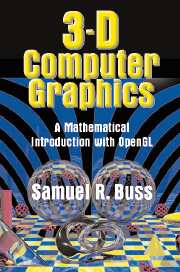Book contents
- Frontmatter
- Contents
- Preface
- I Introduction
- II Transformations and Viewing
- III Lighting, Illumination, and Shading
- IV Averaging and Interpolation
- V Texture Mapping
- VI Color
- VII Bézier Curves
- VIII B-Splines
- IX Ray Tracing
- X Intersection Testing
- XI Radiosity
- XII Animation and Kinematics
- A Mathematics Background
- B RayTrace Software Package
- Bibliography
- Index
- Plate section
IX - Ray Tracing
Published online by Cambridge University Press: 05 June 2012
- Frontmatter
- Contents
- Preface
- I Introduction
- II Transformations and Viewing
- III Lighting, Illumination, and Shading
- IV Averaging and Interpolation
- V Texture Mapping
- VI Color
- VII Bézier Curves
- VIII B-Splines
- IX Ray Tracing
- X Intersection Testing
- XI Radiosity
- XII Animation and Kinematics
- A Mathematics Background
- B RayTrace Software Package
- Bibliography
- Index
- Plate section
Summary
Ray tracing is a technique that performs, by a single unified technique, global calculations of lighting and shading, hidden surface elimination, reflection and transmission of light, casting of shadows, and other effects. As such, it significantly extends the local lighting models such as the Phong and Cook–Torrance lighting models from Chapter III. Ray tracing also eliminates the use of a depth buffer for hidden surface determination. In addition, it allows for many special effects and can create images that are more realistic looking than those that can be easily obtained by the methods we have discussed so far.
With all these advantages, ray tracing sounds too wonderful to be true; however, it has the big disadvantage of being computationally very expensive. Indeed, a single ray-traced image may take minutes, hours, or occasionally even days to render. For example, modern computer-animated movies routinely use ray tracing to render scenes; it is not unusual for an average frame of a movie to require an hour of computation time to render, and individual frames might require 10 hours or more to render. A quick calculation shows that this means that a movie with 24 frames per second, lasting for 100 minutes, may require 6,000 CPU days to render, which is over 16 CPU years! It is fortunate that individual frames can be ray traced independently in parallel, and it is common for animated movies to be developed with the aid of hundreds of computers dedicated to rendering images.
- Type
- Chapter
- Information
- 3D Computer GraphicsA Mathematical Introduction with OpenGL, pp. 233 - 256Publisher: Cambridge University PressPrint publication year: 2003



